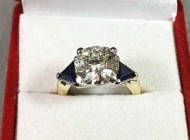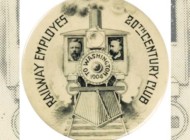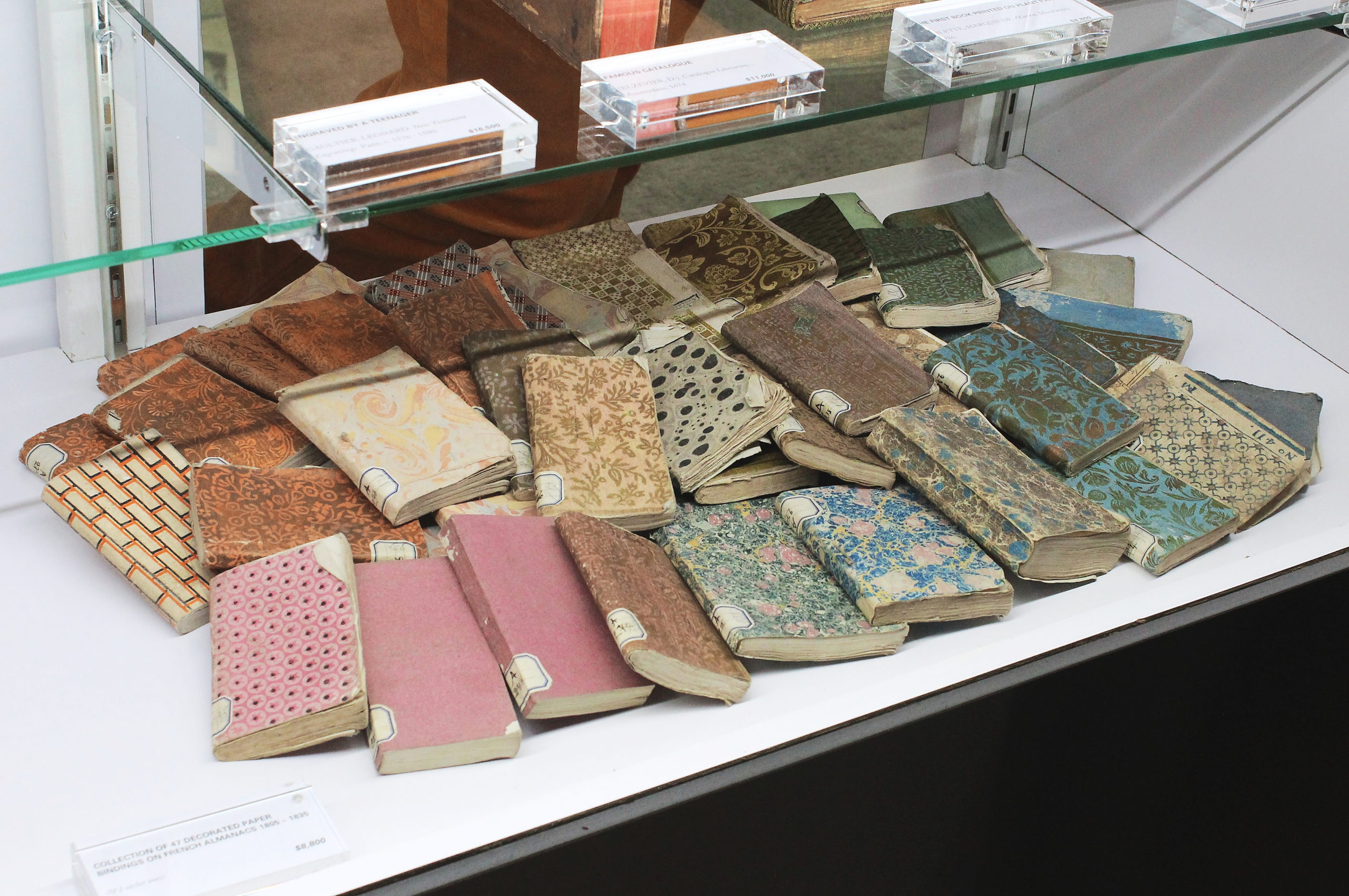
This colorful collection of French almanacs counted 47 volumes, dating from 1805 to 1835. Knuf Rare Books, Paris.
Review & Onsite Photos by Z.G. Burnett
NEW YORK CITY — In contrast with traditional antiques and art shows, the 63rd New York International Antiquarian Book Fair (NYIABF) carries with it an air of fantasy, especially for book lovers. Organized by the Antiquarian Booksellers’ Association of America (ABAA) and produced and managed by Sanford L. Smith + Associates in the Park Avenue Armory, NYIABF offers 55,000 square feet of rare books, illuminated manuscripts, illustrations, photographs, prints, maps and ephemera in almost every subject from ancient texts to art books from contemporary presses. Nearly 200 exhibitors from 17 countries brought their finest wares, laureling the prestigious fair with an extraordinary lineup that annually draws those in pursuit of knowledge that is only forbidden depending on one’s budget. More than 1,500 visitors celebrated the fair’s opening on April 27 and 12,000 overall during the weekend, a 26 percent increase in attendance compared to 9,500 in 2022. This was 15 percent above the previous year’s peak, which marked the 63rd NYIABF as the most successful installment of the fair in the past decade.
Opening nights are often the place to spot celebrities, but at NYIABF it was certain distinguished tomes that were drawing crowds. Perhaps the most high-profile of these was found at the booth of Peter Harrington, London, William Shakespeare’s First Folio, “universally hailed as the most important book in English literature.” Published in 1623 by Shakespeare’s close friends and colleagues John Heminges and Henry Condell following his death in 1616, the folio contains 36 of his plays, half of which would have been lost without their efforts. According to Harrington’s listing, “[the folio] has been credited with shaping and solidifying Shakespeare’s influence on the English language.” To commemorate the First Folio’s 400th anniversary, Harrington offered each of the four folios separately. At the time of the fair, Folio Four had already sold, as had the first collection of Shakespeare’s Poems, published in 1640. This offering was historic in itself; it was the first time in two decades that all of these volumes were presented together, and “the first time in living memory that they have been offered together for sale.” Attendees stood in line around the booth to catch a glimpse of the First Folio on its emerald velvet support, and only a few were able to come close enough to turn its pages.
Another master of their trade was present at the booth of the Manhattan Rare Book Company (MRBC). Bill Watterson (American, b 1958), reclusive author of the comic series Calvin and Hobbes, sent signed color proofs as thank-you gifts to select newspapers who carried the 3,100-strip run from 1985 to 1995. This large format proof was particularly significant as it showed the series’ final page, titled “Let’s Go Exploring.” “It was certainly the most popular item this year,” said Charles Tolkien-Gillet of MRBC. “Often passers-by had immediate reactions to seeing what is, I suppose, a rather different sort of item for the fair, in addition to particular scarcity of Watterson material in general. And that was really nice to see, and to hear how much Calvin and Hobbes continues to mean in people’s lives.” It was announced earlier this year that Watterson is coming out of his nearly 30-year retirement with The Mysteries, “a fable for grown-ups,” expected this October. Another customer favorite was MRCB’s first edition of Reginald Scot’s The Discoverie of Witchcraft (1584) from the Biblioteca Lindesiana, “not least for the ‘decapitated’ head cut.”
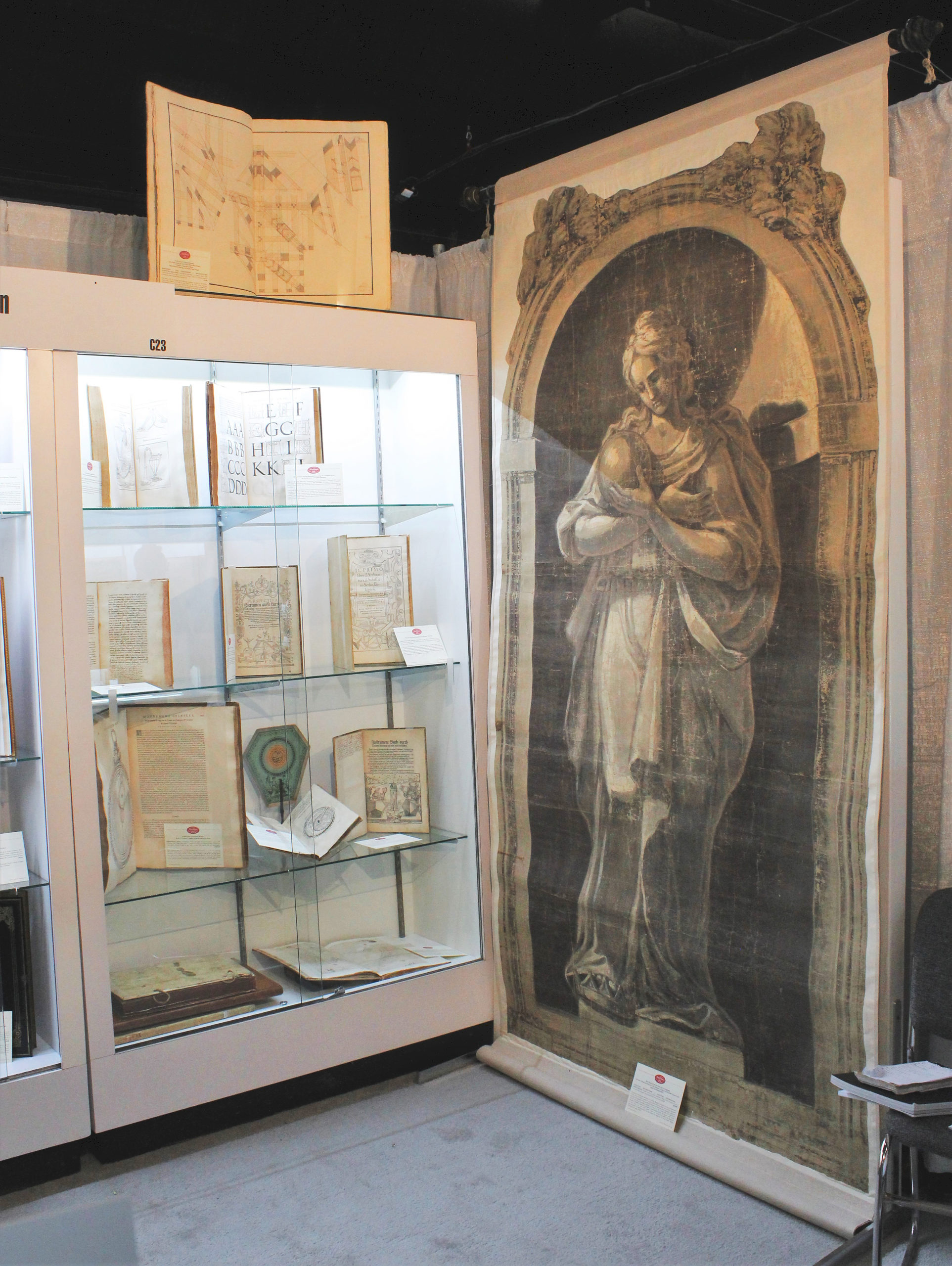
Photographed for scale, this over-life-sized grisaille painting of the allegorical female figure Humilitas in an architectural niche is a rare surviving example of decoration would have been used in a theatrical production or festival in Eighteenth Century Italy. This representation is after an illustration in Cesare Ripa’s Iconologia (1603).
Illuminated manuscripts were a major focus of the sale, represented by two of the foremost dealers in the rare books business. One of the many jewels of the Les Enluminures, Paris, booth was the “Signed Hours,” by Jean of Tours of the workshop of Jean Poyer, assisted by another illuminator. Tours was a center of the French Renaissance in the Sixteenth Century due to the presence of Italian artists and royal patronage, which spurred the Poyer workshop’s success. Les Enluminures’ assistant art director Tomas Borchert explained that the “Signed Hours’” illustration format featured full-page miniatures, at least one of which was remarkably signed, and rich border decorations, which was a departure from the marginalia and in-text miniatures of earlier manuscripts. The grand format of the miniature and its fresh condition, “the present manuscript survives as a visual tour de force.”
Another illuminated French manuscript from this period was showcased by Dr Joern Guenther Rare Books, Basel, Switzerland, known as the “G and H Book of Hours” which refers to the coat of arms and initials of an unknown patron who is portrayed in two miniatures. Illuminated by the Master of “Spencer 6,” whose style is much like that of Jean Colombe of Bourges, the manuscript shows 36 large and 35 smaller miniatures. According to Guenther, the smaller images opposite larger illustrations were added later, some over the manuscript’s text; the reasoning behind this is unknown. The manuscript also contains a fully illustrated calendar that is similar to the “Très riches heures” of the Duc de Berry, which Colombe finished after it was started by the Limbourg Brothers in the early Fifteenth Century. It is possible that the illuminator of “G and H” was able to reference this masterpiece directly in Colombe’s workshop.
More unusual in this category was an illuminated Armenian manuscript scroll known as a hmail, or collection of spells from Globus Rare Books, San Francisco. Hmail were used as traveling amulets throughout Armenia, consisting of prayers and spells with elements of “folk Christianity.” Globus consulted with specialist Dr Davit Ghazaryan (Matenadaran, Mashtots Institute of Ancient Manuscripts in Yerevan, Armenia), who determined that this scroll was written in Bardzr Hajq in Upper Armenia by an artist who both illustrated and wrote the calligraphy of the scroll, signing his name as “the sinful deakon Jakob [sic]” in the colophon. Although not rendered by a specialized illuminist, the length and quality of this work indicates Jakob’s mastery of the medium. The use of hmail continued through the Eighteenth Century, however, few survived due to constant use, making this scroll’s preservation all the more remarkable.
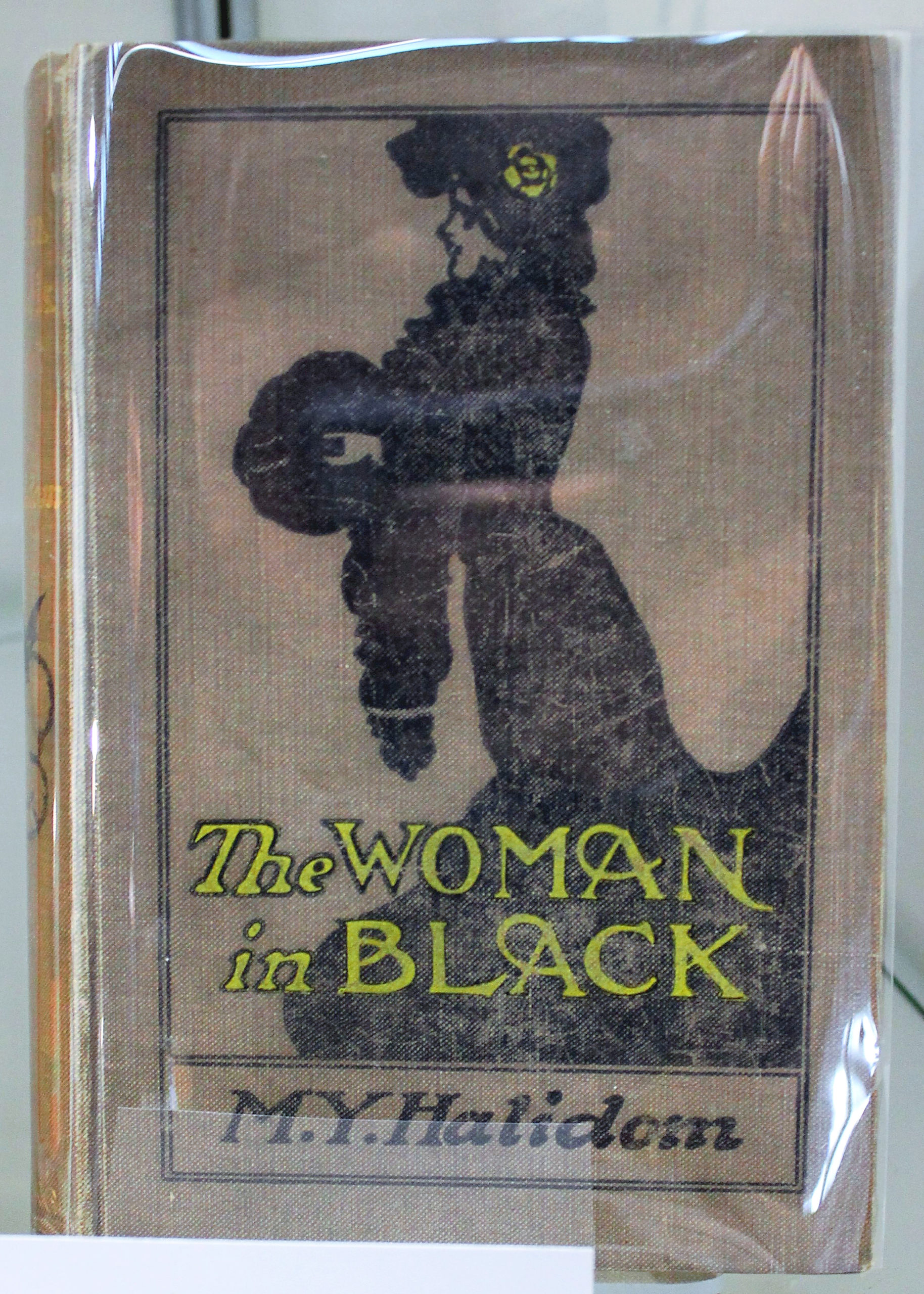
Not to be confused with Susan Hill’s 1983 novel of the same name and its subsequent film adaptations, M.Y. Halidom’s 1906 The Woman in Black is a supernatural vampire thriller set in a small English village. This first edition from John W. Knott Jr of Laurel, Md., who specializes in science fiction and fantasy novels, is exceedingly rare.
While many customers come through NYIABF in search of specific books, a few booths offered entire libraries for sale. One such dealer was Type Punch Matrix of Silver Spring, Md., which displayed selections from the library of the 21 Club that was being sold intact. Each of these titles were inscribed to the club’s host Maxwell “Mac” Kriendler (1907-1973) or to his brother and founder of the club, John “Jack” Carl Kriendler (1898-1947), from prominent literary, theatrical and film personalities. Many of these were signed at the club, and members by bestsellers were stocked behind the lobby tobacco counter. One of these was a copy of How To Travel Incognito by Ludwig Bemelmans (Austrian/American, 1898-1962), best known for the Madeline children’s book series. Reminiscent of his wall murals at the nearby Carlyle Hotel’s Bemelmans Bar, the author and artist’s autograph and inscription to Mac was accompanied by a sketch of an upraised arm holding a martini. Other titles included the vocal score for Rodgers and Hammerstein’s Oklahoma!, a signed copy of Joan Crawford’s 1962 autobiography and St Clair McKelway’s Gossip: The Life and Times of Walter Winchell (1940), the columnist who was banned from the 21 Club who then spurred a Prohibition raid on the establishment in revenge. Embry Clark shared after the fair that although it drew great interest from the crowd, the “21” library is still available at the time of this report.
Fashion illustration is a major category of NYIABF, sought-after by collectors and designers alike. Capitol Hill Books, Washington DC, brought a complete wartime archive by an Englishwoman named Gladys Warren that was possibly created while she was a member of the Women’s Auxiliary Air Force. Many of the illustrations showing women in the latest fashions or uniforms, two historic fashion illustrations and one nude, indication that this may have been Warren’s professional sample dossier. The watercolors and sketches were made on the verso of what appear to be mimeographed World War II aircraft maintenance reports, and there were 26 in the collection altogether.
The word “ephemera” is defined by the Oxford English Dictionary as “things that exist or are used or enjoyed for only a short time,” a word which does not apply to the rare, delicate stock in the booth of Daniel Crouch Rare Books, New York City. Within the cases were vibrant hand-colored maps, board games, card games and more, including a collection of early to mid-Nineteenth Century tabletop games with lithographed and hand-painted cutout pieces. One of these was “Die Ferien im Schloss,” or “Holidays at the Castle,” made by an unidentified Germany toymaker. Containing a board, six painted figures of well-dressed women and background pieces of a castle and two benches, the object of the game was to line up three of the ladies according to the color of their dresses. Another was “Der Wildpark: The Zoological Garden,” a game created in 1843 by court gardener Peter Joseph Lenné for King Frederick William IV of Prussia, based on his own private gardens and menagerie.
The New York International Antiquarian Book Fair occurs annually at the Park Avenue Armory, 643 Park Avenue between 66th and 67th Street. For additional information, www.nyantiquarianbookfair.com.












































